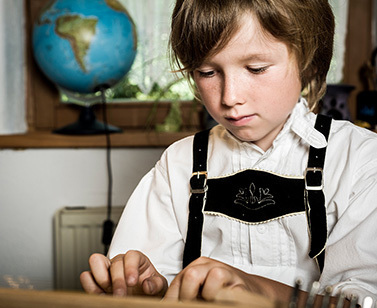Categories Info
Information
The KernSoundboard, which was developed in 2003 is similar to the shape of a dulcimer and has 22 strings. It sounds pleasant and soothing. The chromatic range lies between c1 and a2 and can easily be tuned using an electronic tuner.
The KernSoundboard can be set up on the floor, on a table, or on a suitable KernSoundboard stand and then played. You only have to pluck it with your fingers, and follow a melody line from left to right, which is noted on a sheet of paper that you can place under the strings. The sheet music repertoire in the form of play guides is simply endless and varies from children’s songs, popular ballads, traditional songs of the Alps to simple classical pieces, folk and rock melodies, whereby you can also play in harmony.
Early music education
If early human development goes from crawling to standing up, then a child, who seeks to develop, could play the KernSoundboard either lying down, crouching down, or whilst sitting. Children can sensitize their level of body awareness (balance) whilst playing, as well as become aware of and locate their body parts, which is an essential part of acquiring cultural skills, such as reading, writing and calculating.
When practicing known or learned songs, the sheet music placed underneath enables self-control and easy self-improvement. First encounters with the KernSoundboard demonstrate that experiences, such as independence, co-ordination of eye-hand movements from left to right (like writing), memorizing learnt things (memory), as well as positive self-awareness, represent significant building blocks in regards to acquiring cultural skills at primary school level. Here, children should always be encouraged to learn on a haptic (sense of touch), optical (sense of vision) and acoustic (sense of hearing) level, meaning they should be encouraged to learn through real sensory experiences.

By plucking the strings, the level of tactile (haptic) sensibility is being increased, and the played and sung melody lines mobilize the hearing, whilst the creative scope for design on the play guide underneath encourages the imagination by means of pictorial expressions (optic level). Working with the KernSoundboard also significantly stimulates cognitive academic development, which come into fruition, because musical experiences with the instrument can be organized at an early level (early music education in kindergarten), and as it can be learned easily and as it is fun.
Recently, scientists have established that playing music actively encourages mathematical skills, as players play their instruments continuously for years.
When plucking bilaterally, both sides of the brain are being stimulated. Research in regards to the psychology of learning have furthermore shown, that fine motor skills in regards to using the fingers also promotes and sensitizes acoustic and speech motoric skills, so that the work with the KernSoundboard also helps to develop the respective stimulating sensitizing processes between hearing and speech skills.
Next to the enjoyable musical and cognitive development, which can be achieved through children making music with the KernSoundboard, it also encourages social skills. Children can easily learn to play melodies, and this can be just as easily achieved by a group. Because this is relatively easy, it leaves room for listening to the others, and to focus on playing together and to develop a sense of rhythm in the widest sense. A joint activity can therefore easily turn into a joyful feeling of togetherness, where children can feel comfortable as individuals, but also empowered.
Therapeutic work
Because it is so easy to access the KernSoundboard, it is also extremely suitable for therapeutic work. Disabled persons may have deficits in regards to thought processes or co-ordination skills, but this does not affect their level of musicality. It is not difficult for them to grasp the rhythm of a melody and to join in. The strings of the KernSoundboard can be plucked easily, and it means that mentally disabled persons may stand in the limelight and enjoy the successes of their small orchestras.
Senior citizens making music
Some say that people return to their youth in old age. This is why the KernSoundboard is ideal to help older people take up musical activities again. Often, older people lose courage and are afraid of making mistakes, they don’t want to make a fool of themselves, and this leads to them becoming lethargic and a little bit like children.

Here again, the KernSoundboard also enables easy access to music, as even inflexible fingers can pluck the strings easily. Because it is so easy to play this instrument, this can lead to spontaneous fun and it encourages older people to approach each other and to sing and play music together. And the songs, which might trigger emotions subconsciously, could enable some people to go back to their origins and to open up to other people and to share things with them.
Making music together
The KernSoundboard is ideally suited for playing with other instruments, such as the zither, dulcimer, guitar, recorder, keyboard or a bass KernSoundboard, which is tuned to a lower octave.

Musical areas of application
The experiences and the feedback received when having children and adults play the KernSoundboard, are always positive. For this reason, the use of the KernSoundboard can be recommended for all ages without restrictions. It is especially suitable for:
-
Early music education
-
Kindergartens
-
Special needs education and curative pedagogy
-
Musical therapy
-
Musical workshops with the elderly
The KernSoundboard has been registered as a utility patent with the German patent office.


